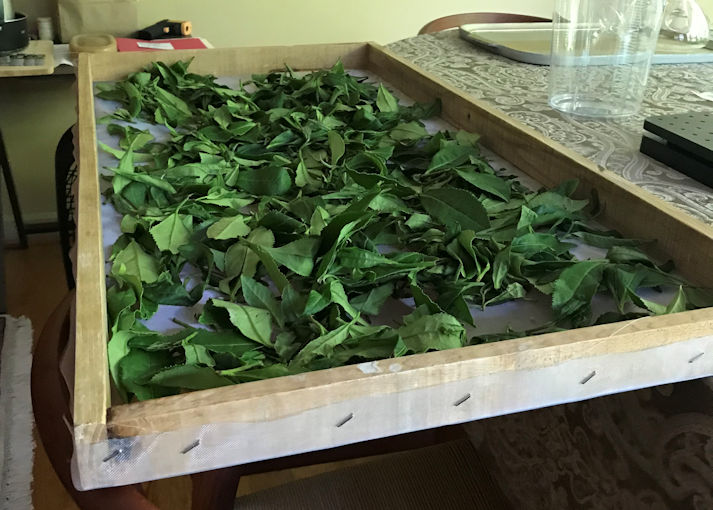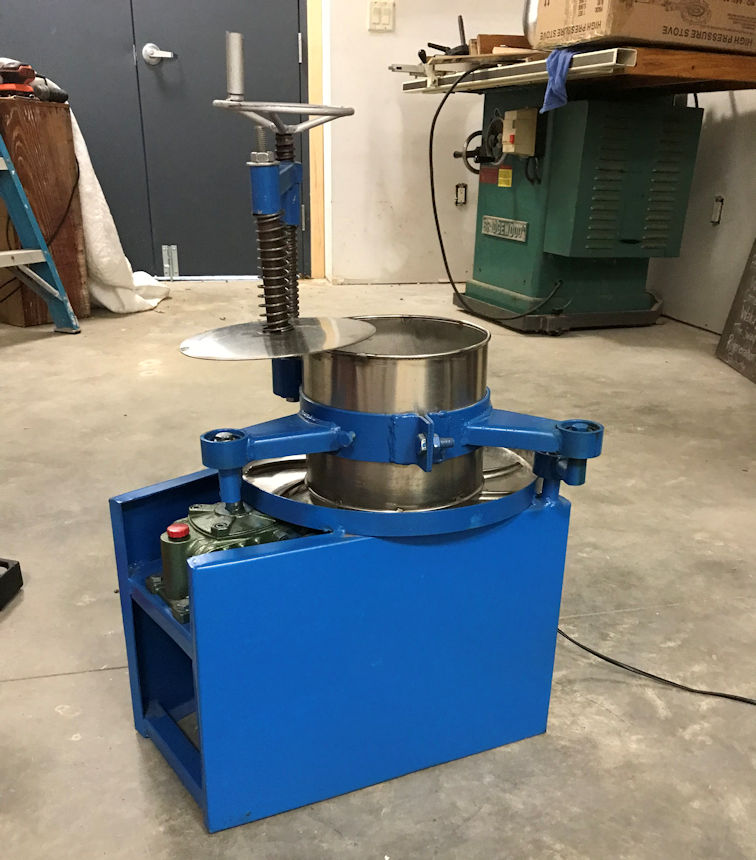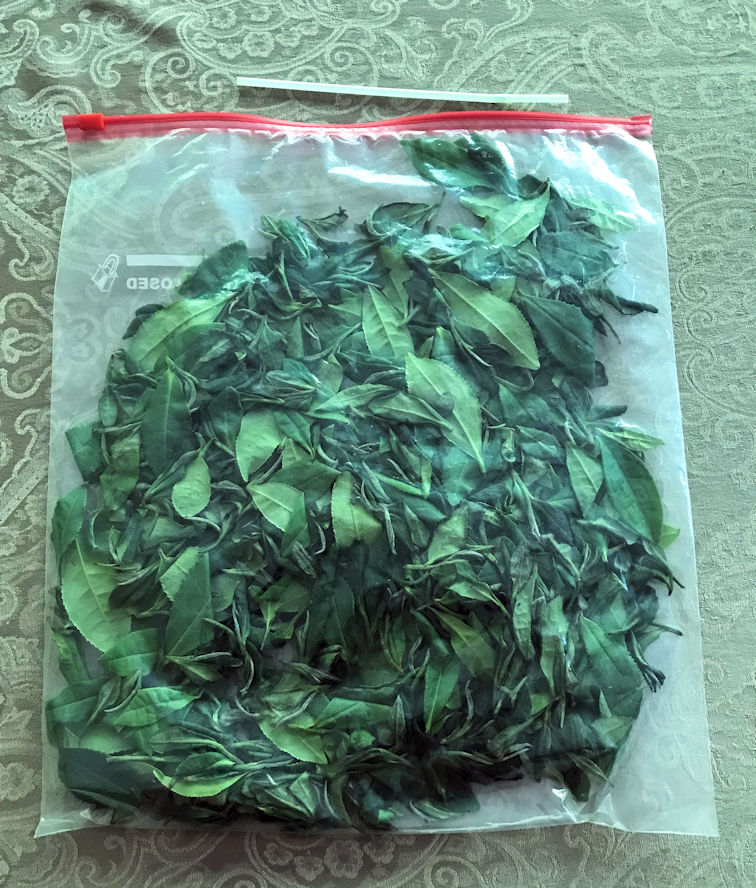Making Black Tea
We gathered leaves one more time last weekend with the goal of making black tea. The leaf handling is different in this method. Rather than preserve freshness, your goal is to have the leaf go brown from oxidation – like leaving a cut apple out on the counter. The flesh of the apple turns brown once it is exposed to oxygen in the atmosphere. Tea leaves do this. Desirable black tea flavors and aromas are formed during oxidation. The process takes longer than making green tea. The leaf can decompose and form undesirable flavors if oxidation is allowed to go too long. It is all about controlling the process.

Toward the end of the overnight whither
We plucked on a Friday evening. The plants we picked from are not irrigated or fertilized. Little regrowth had occurred at the sites that we had plucked for our earlier green tea production. Most of our material came from growth that we did not get with the previous two pluckings along with a few shoots that had grown from previous plucking points. Fourth and fifth leaves on the older shoots were still soft with the lighter green color of new growth. We plucked those as long as the leaves were the proper consistency to be rolled. We ended up with just under a pound of leaves (0.97 lb actually). We brought the leaves home and set them out to wither overnight. The wither goal is 40% moisture loss over 14-16 hours. Fourteen hours gives the greatest level of floral aromas that will decline after that time point. Longer withers might also allow your leaves to spoil. Our local relative humidity was 60% with a temperature of 60°F during our overnight wither. Checking weight along the way found that the rate of weight loss was not progressing rapidly enough to hit our desired level by the 14 hour point. In the morning, ten hours in to the wither, we moved the leaves into the sun for 45 minutes, then back to the processing room. This helped by roughly doubling the hourly moisture loss. At 14.5 hours we had lost 32% of the weight. We were concerned about dragging out the process too long. The moisture loss seemed close enough. Time to roll.

Mighty little roller
Rolling is used to break up the leaf and expose the inner structures to the atmosphere so oxidation can occur, like cutting the apple. An adequate roll can take 45 minutes. This can be done by hand, but it is hard work. A machine to handle the task was invented in the 1870s. Rolling machines are now a critical part of processing tea. As we were learning about tea processing last year, random internet searching turned up a used tea rolling machine for sale on eBay, local pick up only. A man outside Atlanta had imported a small machine to use while he tried his hand at tea making. He was starting a new job on the west coast and was clearing out items ahead of his move. Brown Dog’s Atlanta agent (older brother) was pressed into service. He was able to pick up the roller and complete the deal. We now had a chance to put it to work.
Rolling involves pressing and rolling the leaves. The process generates heat that can sour the leaves so it is done for five minutes then stopped to break up the tightly formed ball of leaves. The leaf is then rolled again. One tip from the US Tea Experience course proved very helpful. The leaves can be contained in a flour sack towel for rolling. This turned out to be very helpful with the small amount of leaf we were processing. Here is the machine in action. We were a little skeptical that it would work. As we approached the 45-minute point, the towel took on a brown color as the leaves released liquid. This is the “moisture break” that occurs when the leaf structure was broken up enough to permit proper oxidation. Rolling was completed at this point.

Wilted leaves prior to rolling Moisture break Rolled leaves
How would we do this step without a rolling machine (a new machine like the one we used would cost $600 + shipping)? We could hand roll. The small volume of leaves we processed could all be rolled in one ball. When doing this you would have to make sure you applied enough pressure during the roll to break the leaves down without shredding them. It would take 45 minutes of this. Freezing and thawing the leaves is another possibility. We have not tried that and worry that the leaves would be too disrupted by freezing. It would be great if it worked. We can add a follow up post if we try it out in the future. Time to oxidize.
The ideal environment for tea leaf oxidation is 90°F and 90% relative humidity. In commercial production the leaves would be put into a closed, controlled space – a refrigerator-like cabinet to hold temperature and humidity or a climate-controlled room. Neither of these is an option for us so we tried to use our oven. We set two pans of water on the oven floor and placed an oven thermometer on the upper shelf. The tea was set into the perforated pan we used with our green tea production. We heaped the tea into a thicker layer than we would have done for final drying.

Our oxidation set up
The minimum temperature setting for the oven is 170°F. To keep the temperature close to 90°F we briefly turned on the oven without convection and monitored the thermometer. In practice we turned the oven on for 1-2 minutes about every 20 minutes. In addition to water from the pans, to keep the humidity at the proper level, every 10 to 15 minutes we would spray water into the oven and on to the tea with a spray bottle. A check with our thermometer/hygrometer – a plastic device set in the oven for for a brief time only – showed a temperature of around 100°F and humidity of 81%. The tea was oxidized for 3 hours in this set-up. At the end it had a real black tea smell. We moved the leaves to our new cake sifter pans, spreading them out in a thinner layer, and removed the pans of water from the oven. We increased the oven temperature to 170°F with the convection fan running. We set the tea back in the oven to dry for 90 minutes following the process described in the green tea posting
So how did we do? At the end of drying, the tea had an odd aroma. It had noticeable green notes. Pretty disappointing. We packed it into two clean, empty tea tins and set it aside. It was sniffed every day or so. After about a week, we started noticing a black tea aroma plus more floral notes than we expected. We brewed a pot using our typical amount of tea to boiling water (10 grams of tea in 2 cups of 212°F water) and gave it a 4-minute steep. It had great color and a strong floral aroma. It was dry in the mouth with light to medium black tea flavors. Yay for us! We put it through three infusions. The color held up across all three of them. The flavors faded with each successive steep as expected but each was enjoyable.

Our first black tea
Addendum – Freezing the Leaves
We went back to the tea plants two weeks after our last plucking. Shoot re-growth was minimal. We plucked half of much as the last effort. Having the smaller amount to process seemed like a good chance to try freezing the leaves instead of rolling for that step. The leaves were picked in the evening and withered overnight for 14 hours. We had a fan blowing under the withering tray for most of that time. We did not expose the leaves to sunlight this time. After 14 hours the leaves weighed 146 gm or 66% of the start weight. This was a 34% moisture loss, not quite the 40% we were shooting for, but close enough.
We learned about freezing the leaves in place of rolling to disrupt the leaf structure from one of the instructors in the black tea making course. He was given the idea while in India. A tea maker told him that after an 18 hour wither they would freeze the tea for 18 hours to speed up rolling.

Leaves ready for the freezer
Once we finished the wither, the leaves were put into a large Zip Lock bag and vacuum sealed Alton Brown-style (a straw placed in the corner was used to suck out all the air before quickly sealing the bag). The leaves in the bag were in a thin, even layer. This went into the freezer. Keeping them in for a time equal to the wither did not make a lot of sense. The leaves are in a steady state once they are frozen. Our wither was completed mid-day during the Memorial Day weekend. Freezing the leaves gave us a chance to step away from processing and check out a few things going on in town.
We got back to the leaves about 5 hours later. They thawed quickly. They looked and felt about the same as they did before freezing. Fifteen minutes of manually rolling did very little to them. The leaves and the towel in which we rolled them remained green. We finished the leaves in the rolling machine. The pressure plate was placed all the way down. The moisture break with brown staining of the towel occurred after 20 minutes of processing. We carried out oxidation and drying as outlined above. The finished tea seems to be the same quality as our first batch.
Freezing did not eliminate the need to roll. Extending the time the leaves are frozen might make a difference but it seems unlikely. Freezing did allow a break in processing. It is probably best to use freezing with small quantities of tea so that the rate or freezing and thawing are consistent in all eaves in the batch.
